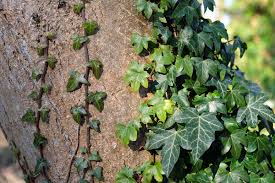Spring has arrived and the winter ceasefire in my personal, perpetual war on English ivy has officially expired. A pile of the severed vines sits in the backyard, waiting to be obliterated in the mulching process. This was only the first salvo of the new growing season, but it gave me enormous satisfaction, not to mention the hope that this year might bring about the ivy’s ultimate banishment from the garden.
Even people who have never thought about gardening can recognize English ivy, or Hedera helix, as botanists call it. The statistics say it all. English ivy, which is evergreen, can grow to a height of 20 to 80 feet tall, and spread from three to 50 feet. Native to Europe, Scandinavia and Russia, the plants sport lobed, dark green leaves in the juvenile phase. And that juvenile phase is rambunctious, allowing the plant to spread and climb. Reaching adulthood, the leaves lose their lobes, becoming elliptical. Unpruned plants produce clusters of tiny light green flowers that give way to black berries. When birds or other animals eat the berries and excrete the seeds, ivy can spread. In the normal course of things, it spreads anyway via a strong root system, thriving in a variety of soils and situations, including shade.
And that fast-spreading habit is ivy’s great problem. Crawling horizontally over the ground it creates a mat of interlaced vines and insidious roots that stomps both weeds and more desirable plants indiscriminately. If it reaches a vertical surface, whether that surface is the side of a house, a tree, or a brick wall, the plants begin to climb, clinging tenaciously. Removing those vines from a painted surface leaves marks. The roots may also do harm to mortar that is in less than tip-top shape. Ivy can find its way into foundation cracks or loose window frames, which is why some homeowners may discover healthy English ivy growing through basement windows. In short, it is a remorseless marauder.
Some people will argue that English ivy makes a great ground cover, especially for areas where lawn grass and most other plants refuse to grow. Unlike grass, it needs no maintenance. It can cover ugly things like chain link fences and deteriorating structures. The dark green leaves are handsome enough to ornament attractive structures like college buildings—hence the nickname “Ivy League” for some of our most august institutions of higher learning.
The previous owner of my house apparently thought ivy was the perfect groundcover for areas that he didn’t want to mow. I don’t know whether he planted a little or a lot. All I know is that by the time I moved in, the ivy was thriving, scaling the south side of the house, working on infiltrating the garage, and generally making a nuisance of itself. I should add that my predecessor also loved the color brown, and applied shades of it to just about every surface inside and outside of the house, including the roof. If it has taken me years to root out the ivy, it has also taken years to obliterate all that brown.
Despite my best efforts, the ivy persists in places, oozing insidiously into garden beds, trying every year to start the process of scaling the house once again, and taking aim at the north side of the garage. I fight back, of course, and have made a great deal of headway, but not enough. In my back garden, I tore out a lot of it several seasons ago, and substituted a bed of hellebores, which are shade lovers, ground coverers, and providers of lovely, long-lived spring flowers. Last weekend, as I pruned the dead leaves off the hellebores, I saw that ivy had begun infiltrating the bed. That ivy is now on the composing pile.
I could wipe it all out with herbicides, but I don’t use them, so vigorous and unceasing uprooting is necessary. This process can be cathartic at times when I am venting my frustrations in the garden. A pile of uprooted ivy is an intensely gratifying sight.
It would be more gratifying if the ivy were completely gone, so the war continues.
Some people still love English ivy, which is why garden centers keep selling it. Serious horticulture websites, like that of the Missouri Botanical Garden, post warnings in red letters: “Weedy and Potentially Invasive: Do Not Plant”. This is because the ivy can jump garden fences, spread into untended or wild areas and outcompete other vegetation, including vulnerable native plant species.
I suppose that English ivy would be fine if you grew it in a large pot, trimmed the stems regularly and kept a close eye on it. However, if you have that in mind, be warned. A prolonged vacation or preoccupation with other issues—like earning a living, caring for family members, or pursuing an absorbing hobby—will give the ivy the opening it needs to embark on a relentless campaign to dominate your space, and probably that of your neighbors.
You have been warned.

